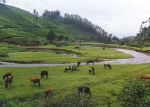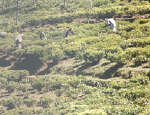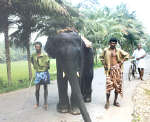An Idyllic Haven


At 5500ft, Munnar is the only hill station in south Kerala that lay snuggled in the high ranges of Western Ghats at the confluence of three mountain streams – Mudrapuzha, Nallathani and Kundala. The spectacular vista of cloud kissed rolling hills carpeted with tea plantations, rivulets dancing through green meadows and the colonial British settlements of the town make this place an ideal getaway from the rigorous strain of daily life.
No wonder then the prestigious Time magazine referred it as one of the very best destinations in India.
Munnar owes its existence to the numerous British planters who cleared large stretches of forests from these hills to cultivate tea on the manicured slopes. Tea still reigns supreme here and Munnar holds the honour of growing tea at the highest elevated land, over 7,200 ft. above sea level. Nearly eighty percent of these estates are owned by Tata Tea Ltd and its holdings. According to the book, Facets of a Hundred Years of Planting (published by Tata Finley Ltd.) the estates initially belonged to Scotsman James Finley some hundred years back. The Tatas purchased them in the 1960s and named it Tata Finley Ltd and finally Tata Tea Ltd.


This idyllic haven is only 130 Kms from the bustling port town of Kochi (Cochin) and 142 kms from the junction of Kottayam, an important town in Kerala. Either way, the drive up to Munnar is a wonderful experience.
We started our journey from Kottayam early in the morning and for the next couple of hours stayed glued to the car windows enjoying the ravishing natural splendour. The winding roads through rolling hills fringed by coconut trees, lime green paddy fields, cascading waterfalls, gently flowing streams and numerous plantations of Pepper, Cardamom, coffee, cocoa, rubber all formed a part of the scenic landscape.
Munnar is a part of the Idukki district, better known as the spice garden in the land of the ‘Kera’ (Coconut) and is most nature rich in the whole state. The fabled Malabar Pepper or the ‘black gold’ and cardamom that brought the Foreign traders to this tiny land crossing the vast stretch of blue water in those ancient times are found here in ample quantity. So much so that the majority of the world’s share of these is supplied from Kerala alone.
The never-ending, all compassing greenery reminded us of the legend heard at one of the tourist lodges. “God created Kerala as his own land and He sent 3000 courtesans to paint the country with only one colour – Green.” And so we encountered the green symphony – soothing, calming, and nourishing.


We stopped at Peermade. The piece de resistance was the Pulluvora waterfall gorgeously tumbling down in a frothy splendour. Lunch was a unique experience at the roadside dhaba. A magenta coloured liquid was served in place of water that smelt strongly of clove and cummin. Shiju, our driver cum guide explained “it is a health tonic and good for digestion.” The biryani tasted like a spicy cocktail and probably had more spice than rice.
The next few kilometers saw us hurtling through the rugged terrain of overhanging cliffs. Then slowly we had a glimpse of the quaint little town of Munnar amidst billiard tabletop smooth tea plantations from afar. At first sight Munnar strikes as a huge neatly decorated garden of green velvet with no hustle bustle, no cacophony and no horns – a perfect choice for those who preferred solitude and peace.
And this feeling of relaxing calm stays with you throughout your stay. When most of the famous hill stations are losing their natural ambience, Munnar still remains a green abode endowed with mountain streams and lakes.
The Tea County Hill resort where we were booked for our three day stay in Munnar was a pleasure itself. It was designed like the previous plantation bungalow with multi cuisine restaurants, bar, health club, recreation centre and the famous Ayurvedic massage that has become synonymous with Kerala. The rooms were tastefully done up with four star facilities and had large picture windows sporting a panoramic view of the valley below. The beautifully laid garden of soft pink roses, vibrant poinsettias and crimson bougainvillea added colour. It even had the Neelakurunji plant that blooms once in twelve years splashing the surrounding Kannandevan hills with bold purple strokes. The next flowering season is due in 2001.


The morning dawned bright and clear and after a heavy breakfast of oven hot parathas and deep-fried potatoes we set out to explore. We went past sloping tea gardens of Rajamalai – a frequent haunt of the film units down south. The lush green gardens looked so uniform that we wondered whether they were gnarled and cut like bonsai. Later our views were confirmed by a planter who said that otherwise the plants would reach up to 7-8 meters, not at all suitable for a good yield. We stopped at a garden to photograph women plucking “two leaves and a bud”. We were fascinated by the efficiency with which they did the job balancing the huge basket on their back at the same time.
Close to the Rajamalai range is the Eravikulum national park – home of the Nilgiri Tahr. This endangered species of mountain goat is nearing extinction and the present population is about 2000 only, majority of which are found only here. The park covers an area of 97 sq.km. and is divided into 3 zones – core, buffer and Rajamalai. Cars can reach up to the Rajamalai region beyond which one can only trek through the forested grassland. Visitors are not allowed in the core area.
As our car began labouring up the plateau, the green fertile tea gardens made way for the rocky terrain. Streams gurgled down the smooth slopes to hit the ground below with vibrant force. Anaimudi (meaning elephant head), the highest mountain peak of the Western Ghats at 2,695 m. could be seen at a distance. Permission for entry is obtained from the wildlife Warden of the forest department’s office at Rajamalai.
This is an altogether different experience in a wildlife park as we walked along a metalled road that zigzagged through the undulating grassland. The walk proved to be an enriching phenomenon as we continuously bumped into visitors from all over the globe. Most of them were fascinated by the simple, laid back lifestyle of Munnar while a few missed the glitz and glamour. Mario Dino, an Italian paediatrician was so enthralled that she wanted to spend her next holiday in the very lap of Munnar again.


We strolled along for sometime and reached a vantage point from where the valley looked enticing in the gentle, nascent sunshine. Suddenly dense cloud rolled over us from nowhere, completely obscuring our vision. It started to drizzle making us worried about the walk down. Soon after, a luminous sun appeared from behind the grey curtain and we wallowed down in sheer bliss with rainbow hued sky as company.
Till then we were not very lucky with viewing animals in the wild. Suddenly lady luck smiled benevolently and we saw a herd of wild elephants grazing afar in the shola forests. The pachyderms were a real go slower and we could make out a family of five with a baby firmly tucked in between. The famous Nilgiri Tahr also favoured us with a visit but from a distance as if to speculate our intentions. Its deep brown skin and melting eyes made it an attractive species.
All of a sudden the quiet mountain was humming with activities as tourists rushed forward to get a closer view. There was a mad scramble for cameras and binoculars and in doing so everyone forgot the basic rules of the jungle. Excited voices echoed all around, the Tahr misinterpreted our excitement and camouflaged itself in the grassland leaving its eager followers completely baffled. We waited for a long time but no, luck did not favour us a second time.
Mattupetty Dam, our next destination, was nestled amidst luxuriant tea gardens boasting splendid views. The district promotion council of Idukki organized boating (both paddle and speed) in the mirror-still waters of the lake that rippled and splashed only when speedboats swerved past. We, however, preferred to sit in the shadow of the surrounding trees contemplating the quiet bounty of nature. The nearby Swiss dairy firm was an example of nature’s harmony with human activities. The well-nourished cows grazing in the lime green valley aptly set against the backdrop of an aquamarine sky was a treat for the eyes.
The CSI church built by the Scottish in 1910 on a rocky outcrop was another discovery. We met a pair of anglers, David John and Asahi trying to fish trout from the flowing waters with stern concentration. We learnt that Munnar has a High Range Anglers’ Association from where one can obtain permission for this sport. It may not interest all tourists but as David put it, “Holidaying to us is to relax and unwind, not a whirlpool activity of hopping from one place to another, Munnar has appealed to us for its laid back approach where we do not have many things to do.”
Next day we headed for the Windermere Estate to glimpse the pepper and cardamom plantations. Rattling through the dense forests of Cardamom trees embellished here and there with vermillion rhododendrons the scenic journey continued till we reached the cottage hutment by the same name. The owner, a retired army officer now looks after this age-old family business. He owns 70 acres of land where cardamom and pepper are grown and exported to the European countries.
Pepper is the dried berry of Piper nigrum. This vine which can grow up to ten feet tall is indigenous to India and Asia. The berries are picked unripe about nine months after flowering, freeze-dried or packed in brine for preservation.
Cardamom, on the other hand, is the ground seed of a tropical fruit in the ginger family known as Elettaria cardamom. It has a pungent, sweet flavour, very intense. In the season the atmosphere around the gardens become heavily scented with Cardamom. The spice is universally liked for its smell alone. The Scandinavians commonly add it to bread and Arabs use it as a flavoring for coffee while Biryani around the world is incomplete without its flavour.
On our return journey from Windermere we visited the Devikulum waterfall. The mountain streams formed a crystal lake called the Sitadevi Lake. Despite the cool November wind local devotees continued to bathe in the cold water here. They also drink this sacred water, believing in its natural curing abilities. The lake is ideal for trout fishing.
That night after dinner we went for a walk in the moonlight. The velvet green gardens in the silvery light created a sylvan landscape just out of an old Hollywood classic. We felt a strong yearning to stay behind but alas…we had miles to go.
Fact FileHow to Go
Kochi (Cochin) is the most convenient place to approach Munnar. It is 130 Kms away and takes about 4 hours to reach. Cochin can be reached by Rail and road from all major towns and it also has domestic and international flights connecting major cities.
Coimbatore, 156 Kms. and Madurai 142 Kms away also have air and rail links.
Roads connect Munnar to all major towns in Kerala and buses ply at regular intervals. Cars may be hired from Kochi.
Pioneer travels (Phone 666148) and Sundale Vacations (M G Road, Kochi) are reliable tour operators from whom you can rent cars at a reasonable rate.
Where to Stay
Besides the Tea County Hill Resort owned by Kerala Tourism Development Corporation, following are some of the standard accommodation in Munnar.
Rs. 1,000 – Rs.3000
Rs 400 – Rs.1000
The Tea County Hill Resort is priced from Rs.2,000- upward and for reservation contact:
Reservation Manager,
Tea County Hill Resort,
Munnar
Kerala 685 612
Phone: 530460
Fax: 91-486-530970
E-mail: [email protected]
For local travel in Munnar request your hotel to organise a vehicle if you are not taking one along. Jeeps and Cars can be hired for Rs.1,400 for a full day tour and Rs.800 for half day. The District Tourism Promotion Council offers cycling facilities at Munnar on a per day basis.
Best Season
November to March.
Clothing
Light Woollen.
For further information:
Tourist Information centre
Park View
Thampanoor
Trivandrum
Phone: 0471-330031
E-mail: [email protected]
Short trips around Munnar
Anaimudi
Munnar offers a mildly challenging 3 hour trek through tea-covered slopes to the peak of the highest mountain in Southern India, the 2,689 metre high Anaimudi, the elephant’s Head. The estate where the trek starts is called Nyamakad.
Top Station
(more than 7,200 ft) 32 Kms from Munnar, at the border of Tamilnadu, this spot offers a spectacular vista of the Western Ghats. This is also the highest tea-growing region.
Chinar Wild Life sanctuary
60 Kms from Munnar, Chinar is the home to Elephants, leopards, gaurs, sambars and spread over an area of 90.50 sq.km. The drive is very scenic and en route you could visit Marayoor sandal wood forest.
For overnight stay, contact Chandana Residency (Ph:04865-52222) or Marayoor Tourist home.
For more detailed information, reservation etc. contact: